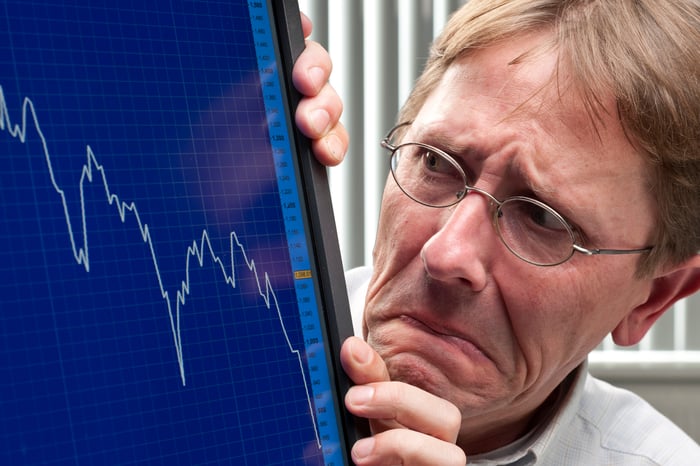Last year was the type of year investors dream of. Both the Dow Jones Industrial Average (^DJI -0.65%) and broad-based S&P 500 (^GSPC -1.20%) crushed the long-term historic annual return of 7% for the stock market, inclusive of dividend reinvestment and adjusted for inflation. What's more, these indexes did so without a single notable downtrend. It was the true definition of a "melt-up."
However, 2018 has been markedly different. In just a 13-calendar-day stretch in late January and early February, we witnessed the Dow and S&P 500 spiral from their all-time highs to official correction territory -- i.e., down at least 10% from a recent high. It marked the first correction investors had witnessed in two years, and it also created more fear -- as measured by the CBOE Volatility Index -- than Wall Street has seen in almost a decade.

Image source: Getty Images.
How long do corrections typically last?
This volatility has a lot of investors wanting an answer to one important question: When will it all end? Unfortunately, that's an answer no one knows. We'll never know with any certainty when a stock market correction will begin, when it'll end, how steep the drop will be, or even what will cause it, in advance.
But what we do have is a mountain of data on previous stock market corrections to help us keep a level head. According to market analytics firm Yardeni Research, there have been 36 corrections in the S&P 500 since 1950 of at least 10%, or about one every two years. Yet, in each and every instance, save for the current correction, a bull market rally has eventually erased the entirety of the decline. The question is: How long do these corrections typically last?
Using data from Yardeni Research, which lists the calendar days between the peak and trough of each correction, here are the lengths of each of the 36 corrections of at least 10% since 1950 in the S&P 500.

Data source: Yardeni Research. Table by author. Correction length listed in calendar days. Red represents corrections lasting longer than 365 days, yellow between 120 and 365 days, and green less than 120 days.
The color coding above represents red for extended corrections of one year or more, yellow for those that lasted an intermediate amount of time (between four months and a year), and green for those corrections that lasted fewer than four months.
Cumulatively, the S&P 500 has spent 7,040 days declining in correction since 1950. Given that there have been 36 corrections, the average correction time is about 196 calendar days over the past 68 years.
Key stock market correction takeaways over the past 68 years
But there's more to this data than meets the eye.
First off, you'll note that we've had seven extended corrections, five of which turned into bear market drops of at least 20% (another missed becoming a bear market by just 1%). Though not all bear markets necessarily take a lot of time to resolve (see 1987), more often than not, bear markets lead to extended or intermediate-term corrections. But, once again, we'll never know ahead of time if a correction will turn into a bear market.
You know what also stands out? The number of green rectangles, and their proportion on the right side of the data table compared to the left. First off, this signifies that 22 of the 36 corrections (61%) in the S&P 500 since 1950 tend to be over with quickly. This means, on average, we only get an extended or intermediate-term correction about once every five years, assuming we stick to the averages, which the stock market usually does not.

Image source: Getty Images.
Secondly, and most importantly, correction length has significantly shortened over the past three decades. Between 1950 and 1984, 11 of the 22 corrections were either extended or intermediate in length. Since then, just three of the past 14 have taken longer than 104 calendar days to find a bottom. I'd attribute this to the advent of the internet and the continuous improvement in the dissemination of information, which has allowed retail and institutional investors to keep a level head.
Since 1987, the average correction length has actually been almost a month shorter than the 68-year average, at 168 days. And, mind you, the only reason the correction length is even this high is because of the lengthy dot-com bubble and Great Recession. Remove those two bear markets from the equation, and the other 12 corrections since 1987 have lasted an average of just 76 days!
Long story short, even though bear markets and stock market corrections are inevitable, long-term investors who regularly invest in high-quality stocks have next to nothing to fear.




